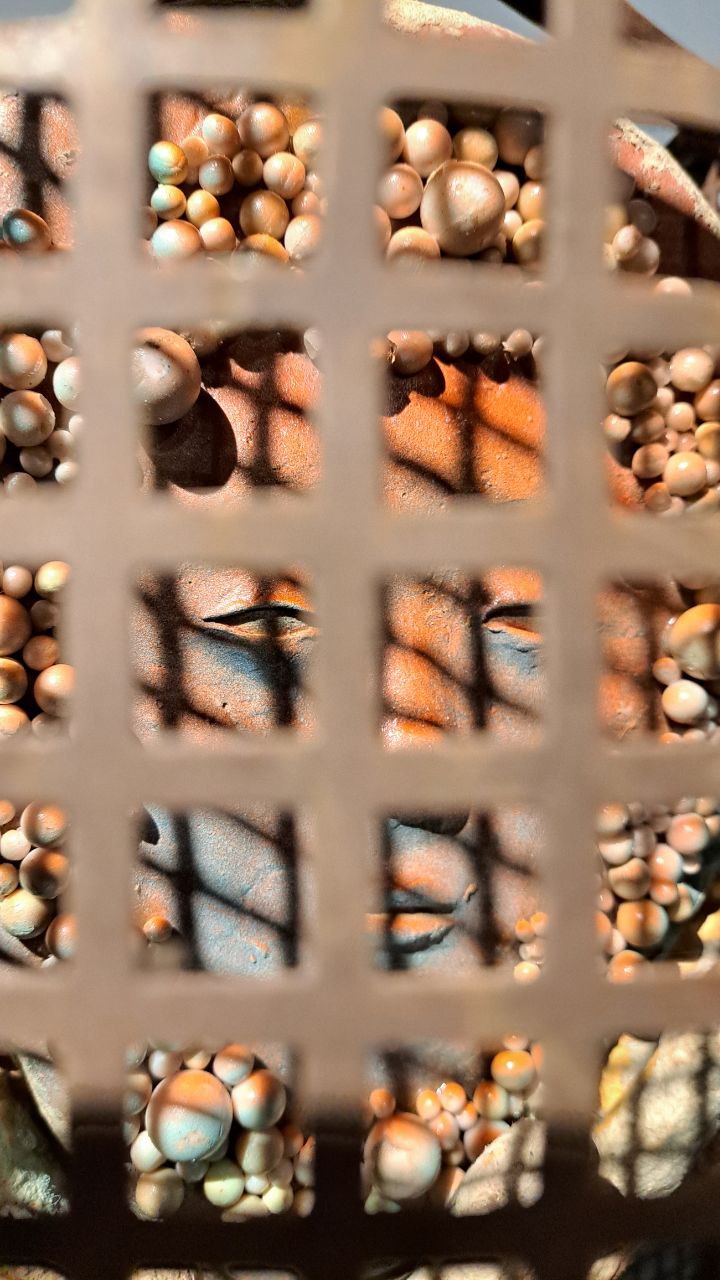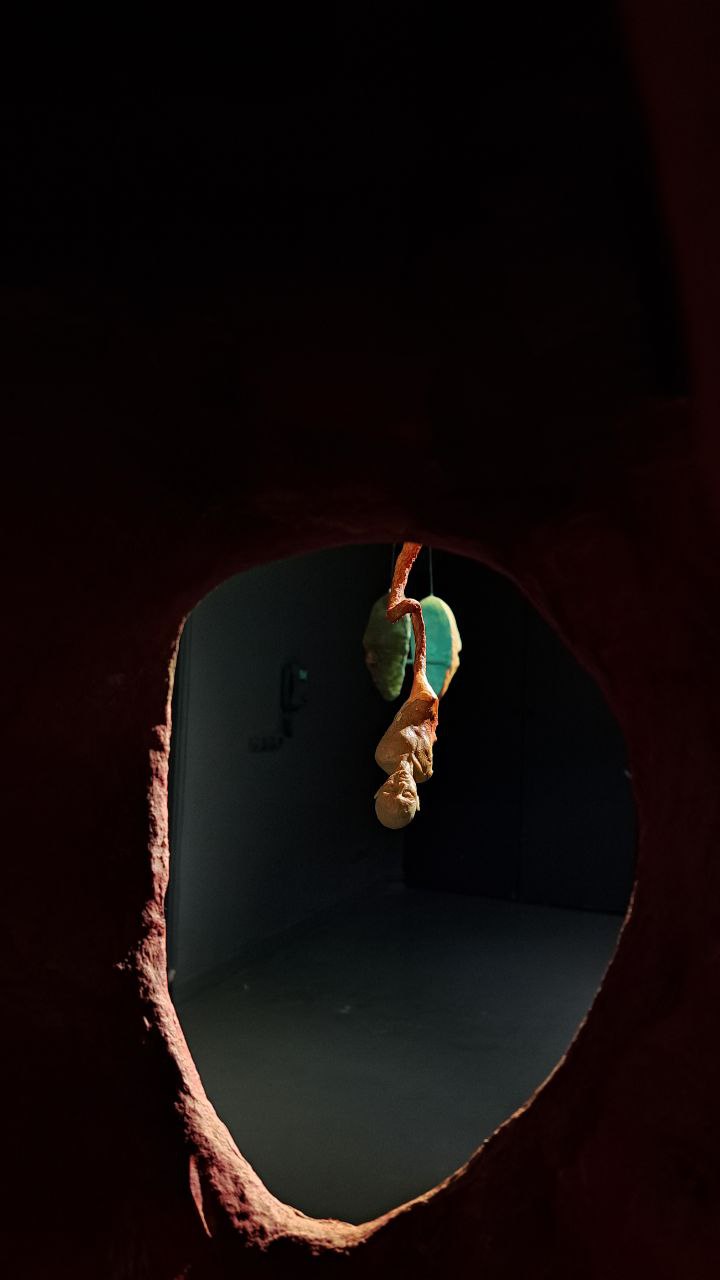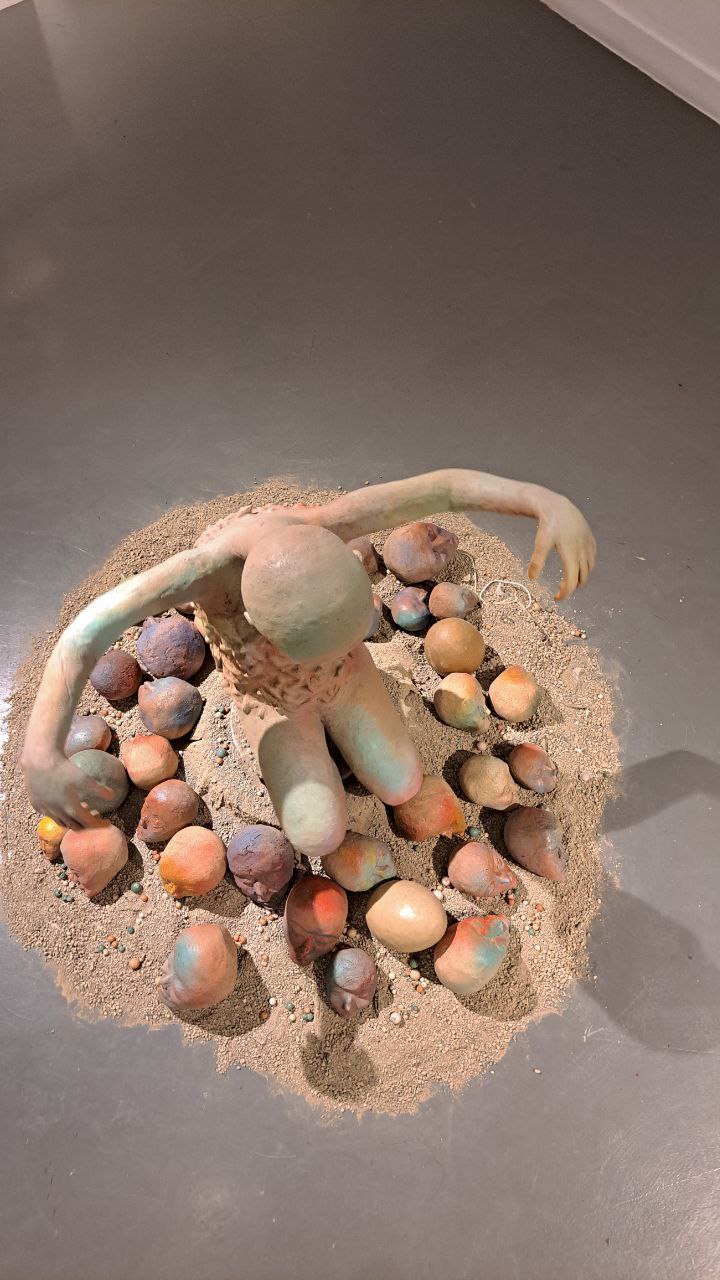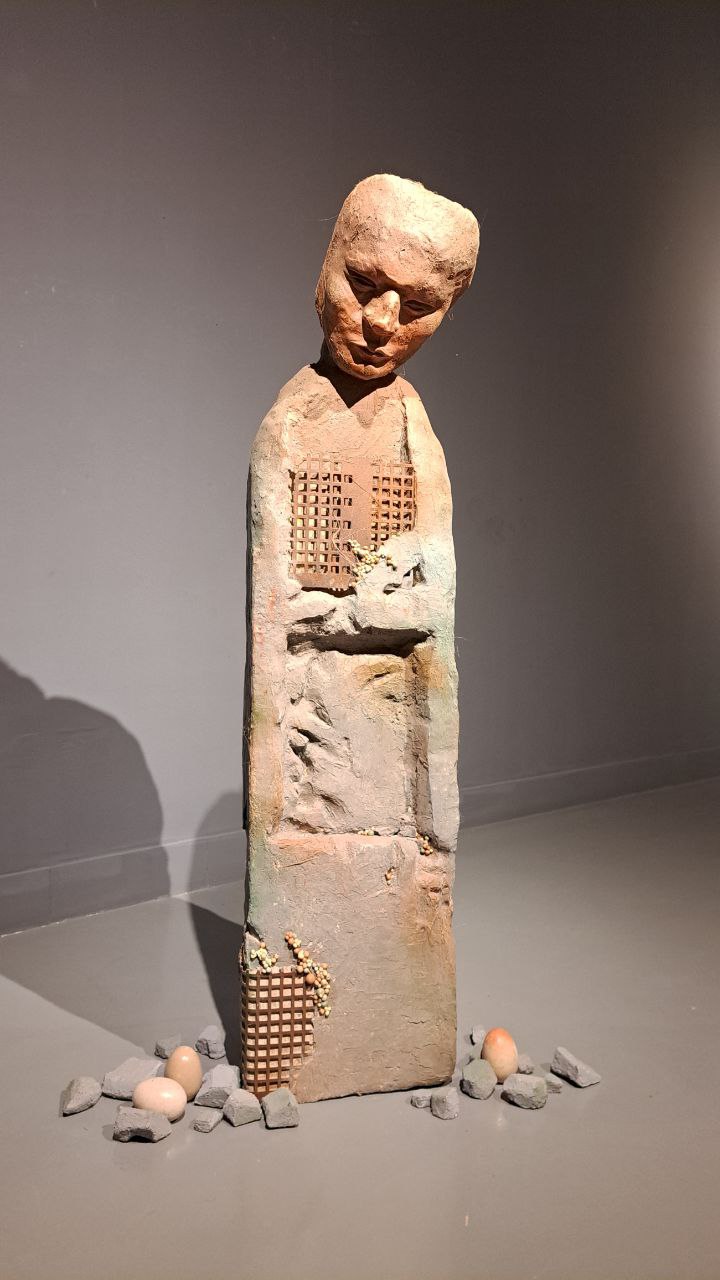نگاهی به نمایشگاه «رویت» هما اشرف منصوری به قلم امیرحسین شریفان
این نوشتار، زاویه نگاهی است شخصی و تحلیلی در مواجه با نمایشگاه انفرادی مجسمه های اشرف منصوری که در تابستان 1404 در گالری شمیس، به نمایش گذاشته شده است.
تمام حقوق این نوشته برای امیر حسین شریفان محفوظ است، استفاده با ذکر منبع مجاز است.
ارجاع به این متن :
https://amirhosseinsharifan.ir/blog/art-analysis-criticism/P1063-A-Look-at-Homa-Ashraf-Mansouri-s-Exhibition-Roo-yat-Sighting-By-Amirhossein-Sharifan.html
واژگان کلیدی: هما اشرف منصوری، گالری شمیس، نمایشگاه مجسمه، رویت، مجسمه سازی معاصر ایران، تحلیل هنری، فلسفه هنر، تجربه حسی، ناپایداری، زیباییشناسی

آثار هما اشرف منصوری در مجموعهی «رؤیت» بیش از آنکه صرفاً مجسمه باشند، در حکم «پرسشهای مجسم» عمل میکنند؛ پرسشهایی دربارهی ماهیت ادراک، حافظه، و تجربهی زیستهی انسان و همچنین کالبد او .به زعم من در این مجموعه، او از زبان پیکرهسازی بهعنوان یک ابزار صرف بازنمایی ای زیبا سازی عبور کرده و آن را به بستری برای تامل فلسفی تبدیل کرده است. این مجموعه به نوعی تجربهای است که در مرز میان هنر تجسمی، فلسفه و روانشناسی ایستاده است
بدن در آثار منصوری، دیگر یک فرم آناتومیک یا زیباشناسانه نیست. انگار او بدن را همچون «بایگانی» میبیند؛ جایی که خاطرهها، زخمها، ترسها و تجربههای زیسته لایهلایه انباشته شدهاند. سرهای بزرگ و ناقص، تنههایی با اندامهای حذفشده و نگاههایی که بیشتر غیاب را مینمایانند تا حضور، همگی بدن را به چیزی فراتر از ماده بدل میسازند. این بدنها شکستهاند، ناقصاند، و در همین نقصان است که حقیقتی آشکار میشود: بدن همواره حاملِ فقدان است. به بیان دیگر، آنچه ما از بدن میبینیم، چیزی جز رسوبِ زخمهای جمعی و فردی نیست.

در بسیاری از آثار این مجموعه ، عنصر «سوراخ» یا «خالیبودن» حضور دارد؛ چه در شکمها و سرها، چه در بافت مجسمهها. به زعم من این حفرهها استعاده هایی فلسفی هستند از غیاب، از بخشهایی از زندگی که هرگز دیده نمیشوند یا عمداً نادیده گرفته میشوند. این حفرهها همان چیزیاند که ژاک دریدا «غیابِ حاضر» مینامید: جایی که نبودن، خود تولیدکنندهی معناست. چشمِ مخاطب ناگزیر میشود به این خلأها خیره بماند و از خلال این نگاه، با معنایی تازه مواجه شود. این امر یادآور حقیقتی بنیادین است: هر ادراک انسانی همواره در دلِ نادیدنیها و غیابها شکل میگیرد.
حضور اشکالی شبیه به تخممرغها، موجودات جنینی یا اندامهای ابتدایی، مجموعه را به ساحت الگوهای کهن و بنیادین و آغازین هستی پیوند میزند. این اشکال هم یادآور خاستگاه زیستی انساناند و هم بازتاب ناخودآگاه جمعی. از منظر روانشناسی، میتوان گفت که هنرمند در حال بازنمایی کشاکش میان میل به بازگشت به «رحم و آغوش آغازین» و اجبار به زیستن در جهان گسسته و واقعی است. منصوری این دو قطب را همزمان در اثرهای خود نگه میدارد؛ نه یکی را بر دیگری ترجیح میدهد، و نه از تضاد آنها میگریزد.

عنوان مجموعه، «رؤیت»، کلید اصلی درک جهان هنرمند است. رؤیت در اینجا صرفاً دیدن فیزیکی نیست، بلکه تجربهی مواجهه با حقیقتی است که در هالهی ترس، خاطره و رویا پنهان شده. منصوری نشان میدهد که نگاه ما همواره آلوده به پیشداوری، حافظه و هراسهای درونی است. هر آنچه میبینیم، با خاطرهها و ترسهای ما درهم تنیده است. بنابراین «دیدن» همواره نوعی «خواندن» است؛ خواندن لایههایی که در عمق ناخودآگاه و در مرز میان واقعیت و خیال رسوب کردهاند. بنابراین هیچ دیدنی ناب و بیواسطه وجود ندارد. در این معنا، آثار او نوعی پدیدارشناسی مجسمه وارند: تلاشی برای آشکار کردن لایههای پنهان ادراک.
از حیث فرمال و متریالی، آثار منصوری بهشدت آگاهانهاند. رنگهای خاکی، سطوح زبر، بافتهای فرسوده و ترکیب عناصر طبیعی چون شن و سنگ، بدن را با زمین و خاک پیوند میزنند. این پیوند اما نه رمانتیک است و نه آرامشبخش؛ بلکه به نوعی یادآور فنا، مرگ و فرسودگی است. ماده در اینجا حامل معناست: بافتِ زبر و فرسوده همانند حافظهای است که بارها خراشیده و دچار فراموشی شده، اما در هر ترک و زبریاش نشانی از حقیقت باقی مانده است.

در پایان می توان گفت ، هما اشرف منصوری در «رؤیت» بیش از آنکه صرفاً مجسمهساز باشد، مانند فیلسوفی است که زبان فلسفهاش گل و خاک و ماده است. او بهجای آنکه بدن را زیبا، کامل یا آرمانی بازنمایی کند، بدن را به میدان کشمکشهای روانی و وجودی بدل میسازد. آثار او نه تنها پرسشی دربارهی ماهیت دیدن و بهیادآوردناند، بلکه به ما نشان میدهند که حقیقت، همواره در لابهلای گسستها، حفرهها و غیابها پنهان است. مخاطب در مواجهه با این مجسمهها، ناگزیر است از سطح عبور کند و به عمق تاریک اما پویای وجود خود خیره شود.
A Look at Homa Ashraf Mansouri’s Exhibition “Roo’yat (Sighting)” By Amirhossein Sharifan
"This article presents a personal and analytical perspective on Homa Ashraf Mansouri’s solo Scupture exhibition, which was held in the summer of 2025 at Shamis Art Gallery, Tehran, Iran"
The works of Homa Ashraf Mansouri in the collection “Roo’yat” (Vision) function less as mere sculptures and more as “embodied questions” questions concerning the nature of perception, memory, lived human experience, and the body itself. In my view, within this collection she transcends the sculptural language as a mere tool of representation or beautification, and instead transforms it into a medium for philosophical reflection. The collection thus inhabits a space at the intersection of visual art, philosophy, and psychology
In Mansouri’s works, the body is no longer an anatomical or aesthetic form. It is as though she conceives of the body as an archive a repository where memories, wounds, fears, and lived experiences are layered and sedimented. Enlarged and fragmented heads, torsos with missing limbs, and gazes that convey absence more than presence all transform the body into something beyond mere matter. These bodies are fractured, incomplete, and it is precisely within this incompleteness that a truth emerges: the body is always a bearer of loss. Put differently, what we perceive of the body is nothing other than the sediment of both collective and individual wounds
Throughout much of the collection, the element of the hole or emptiness recurs whether in the abdomens and heads or within the very textures of the sculptures. To me, these voids are philosophical metaphors for absence, for those dimensions of life that are never seen, or deliberately overlooked. These cavities are what Jacques Derrida once described as a “present absence”: a site where non-being itself becomes generative of meaning. The viewer’s gaze is compelled to linger within these voids, and through this act of staring, encounters a new layer of meaning. This recalls a fundamental truth: every human perception is always shaped in and through the unseen, the absent, and the invisible
The presence of forms resembling eggs, embryonic beings, or primordial organs links the collection to archetypal and originary patterns of existence. These forms simultaneously recall humanity’s biological origins and the reflections of the collective unconscious. From a psychological perspective, one might say the artist is representing the tension between the desire to return to the “womb and primal embrace” and the compulsion to inhabit the fragmented, tangible world. Mansouri holds both poles together within her works neither privileging one over the other nor fleeing from their tension
The title of the collection, “Roo’yat” (Vision), is the key to entering the artist’s world. Vision here is not mere physical sight, but rather an encounter with a truth shrouded in fear, memory, and dream. Mansouri reveals how our gaze is always tainted by prejudice, memory, and inner anxieties. Everything we see is intertwined with our own fears and recollections. Thus, “seeing” is always already a form of “reading” a deciphering of layers sedimented within the unconscious and suspended between reality and imagination. Pure, unmediated vision does not exist. In this sense, her works constitute a kind of phenomenology of sculpture: an effort to unveil the hidden strata of perception
Formally and materially, Mansouri’s works are intensely deliberate. Earthy hues, rough surfaces, eroded textures, and the incorporation of natural elements such as sand and stone bind the body to the soil and to the earth. Yet this connection is neither romantic nor pacifying; rather, it recalls decay, mortality, and erosion. Here, matter itself is the bearer of meaning: the rough, worn surfaces resemble a memory repeatedly scratched and eroded, yet in every fissure and abrasion a trace of truth remains
Conclusion
In “Roo’yat”, Homa Ashraf Mansouri is far more than a sculptor; she is akin to a philosopher whose language is clay, earth, and matter. Instead of rendering the body beautiful, complete, or idealized, she transforms it into a site of psychological and existential struggle. Her works are not only inquiries into the nature of vision and remembrance, but also show us that truth always resides within ruptures, voids, and absences. The viewer, in confronting these sculptures, is compelled to move beyond surface appearances and to gaze into the dark yet dynamic depths of their own being.
